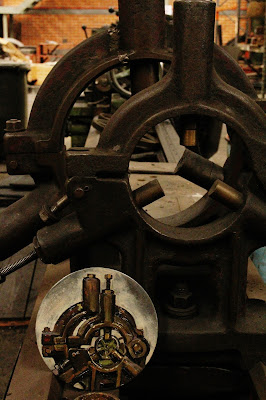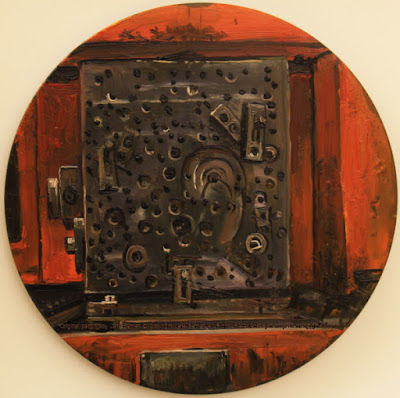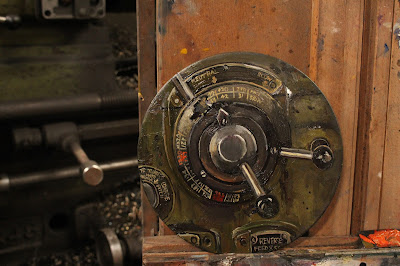I've been painting the machinery in the William Wallbank and Sons ex- foundry in Auburn, before it is all stripped out and sent to a scrap metal yard.
 |
Work in progress - AWW8 'Boys toys -Steady rest 1' oil on steel press plate tondo 16 x 16cm 2017 Available |
I've been painting a series of still life studies on salvaged "press plates".
These leftover circles of mild steel were found lying on the machine shop floor, and were being gathered up to be thrown away.
 |
AWW8 'Boys toys -Steady rest 1' oil on steel press plate tondo 16 x 16cm 2017 Available |
It was fascinating painting the relics of industry on salvaged objects that were part of the waste product from that industry.
The lustre of the smooth metallic surface shows through every brushstroke, reproducing every sparkle, shine and glimmer of the knobs and finials.
 |
Work in progress - AWW11 'Boys toys -Steady rest 2' oil on steel press plate tondo 16 x 16cm 2017 Available |
Although the William Wallbank foundry dated from 1932, some of the machinery was much older. I found a nameplate on one from "Russia", which meant that it must have dated from before the Soviet era, and probably from before World War I.
 |
AWW11 'Boys toys -Steady rest 2' oil on steel press plate tondo 16 x 16cm 2017 Available |
The steady rest on a lathe, has a frame and 3 adjustable jaws to support a workpiece such as an axle or a shaft while it is being turned, milled or drilled.
It prevents slender, flexible pieces springing back and forth, and also allows deep cuts, drilling, boring, or internal threading.
 |
Work in progress on the easel - AWW10 'Boys toys -Boring machine' oil on steel press plate tondo 16 x 16cm 2017 Available |
The over arm with the top jaw can be unfastened and swung out of the way so that pieces can be removed and replaced without needing to adjust the jaws.
There should be 0.001 inch clearance between the jaws and the workpiece.
The bearing surface is usually machined directly on the work.
 |
AWW10 'Boys toys -Boring machine' oil on steel press plate tondo 16 x 16cm 2017 Available |
When the work is too small or awkwardly shaped to machine the bearing surface, a 'cathead' can provide the bearing surface.
The cathead has a bearing that is surfaced, a hole through which the work extends, and adjusting screws to fasten the cathead to the work.
 |
Work in progress on the easel - AWW9 'Boys toys -Control' oil on steel press plate tondo 16 x 16cm 2017 Available |
When it isn't possible to hold the work in the chuck, one end can be supported by the headstock centre and the other by the steady rest.
A leather strap or rawhide thong is used to tie the work to the driveplate and to prevent it from moving off the headstock centre.
 |
Work in progress on the easel - AWW9 'Boys toys -Control' oil on steel press plate tondo 16 x 16cm 2017 Available |
After the locking screws on the adjustable jaws are tightened, the bearing surface needs lubrication with heavy oil before turning on the lathe.
 |
Work in progress on the easel - AWW9 'Boys toys -Control' oil on steel press plate tondo 16 x 16cm 2017 Available |
The bearing surface and adjustable jaws always need a heavy oil film between them, as when the workpiece heats up it will expand, closing the distance between it and the jaws.
 |
AWW9 'Boys toys -Control' 2017 oil on steel press plate tondo 16 x 16cm Available Related posts |








